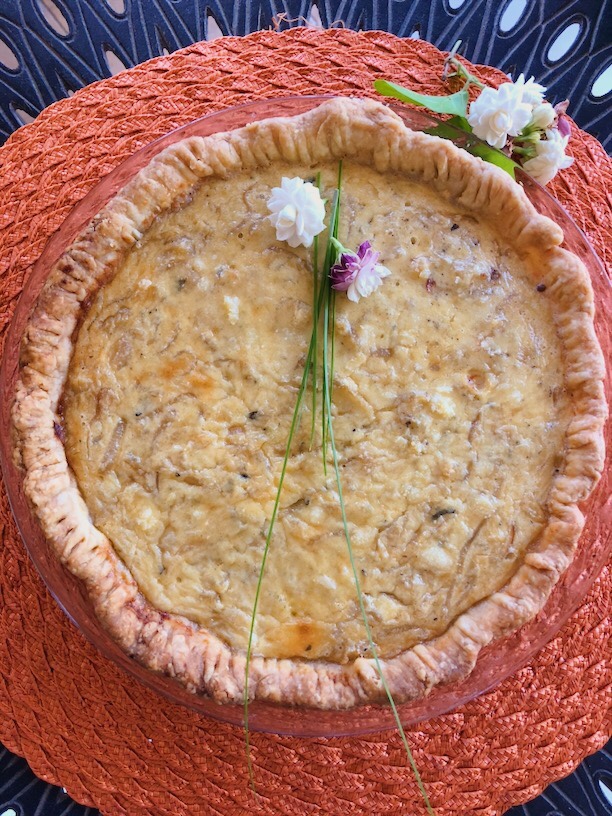So many people say that pastry making is difficult and the outcome is never favorable. I hear this time and time again from so many. I have been making pastry at home for about 30 years and it’s become second nature to me. I can whip it up in no time. I have tried so many recipes over the years. Some are good and some not as good. I have a good blend of fat to flour ratio which works perfectly. Here are a few key tips when making pastry that need to be observed.

An onion tart using the pastry recipe indicated. Recipe found on blog.
Pastry recommendations
1. Pre-measure all of your ingredients.
2. Pastry measures need to be precise.
3. Butter should be cold.
4. Ice water is necessary.
5. Do not overwork dough.
6. Pastry dough needs to rest before using.
7. Never pour a hot filling into an unbaked pie dough. Always allow the filling to cool completely.
8. You may add a warm filling to a pie base that has been baked blind.
I like to use the food processor as it cuts down in time for me and because I usually am making large quantities. However, pastry can be effectively done by hand without the use of a machine. In the images below I am doing a pie dough by hand. I like the combination of butter and shortening. If you prefer, you can use all butter in the recipe by just substituting the quantity of shortening by butter.This pie crust pastry can be used for making pies, tarts, small pastries sweet or savory. It is the quintessential recipe for all pie making.
This recipe makes 2 8-10″ single crusts or 1 covered 8-10″ pie or about 12 3″ tartlettes.
Shortcrust pastry or Pate brisée
Ingredients
2 ½ cups all purpose flour
6 ozs butter, cubed
2 ozs vegetable shortening
1 tsp salt
1 tsp sugar
⅓ cup Ice water to mix + 1-2 tsp if necessary
Method
In a large bowl place flour, salt and sugar. Mix together with a whisk.
Add the butter and shortening in cubes. Work together with your fingers to a sandy texture, ensuring that there are no large chunks of butter or shortening remaining. I use a dough blender instead of my fingers to breakdown the fat into the flour. You can also use a fork if you’d like. Your fingers will work just fine as well if you prefer.


This image indicates the texture needed before you add the water.
Add the half of ice cold water and then 1 tbsp at time to form a dough. It should mix to a firm but soft pliable dough. Do not over mix!!!

If your dough has still not come together and you still have a few shaggy pieces add an additional teaspoon of water. You absolutely do not want a soggy dough or you will have to add extra flour to compensate and this will throw the ratio off.

Do not overwork the pastry!!! This will make your pastry tough and rubbery instead of tender and flaky.
Roll into a ball and then separate into half forming 2 disks. Wrap in plastic. Refrigerate for at least 30 minutes.

On a floured surface, cut the pastry disk into half and roll to make a pie or tart or small tartlets.
Here are some images on rolling the dough for the pie crust.

Flour a work surface and roll one of the disks to about 11-12″ diameter. Using the rolling pin, roll the round over the rolling pin and place over the pie dish. Allow the pastry to sit flat in the base. Let the excess dough hang over the edge and then trim the excess off leaving a slight extra edge as the pastry will shrink as it bakes.

Trimming of the excess pastry with kitchen scissors

I fold the edge slightly and then make a pattern on the edge indenting the pastry with 2 fingers.

You can also use a fork to press the edges down like this.


Depending on the type of pie and the recipe you are using, you may be instructed to bake the pie blind. This means that you bake the base for about 15-20 minutes before pouring in your filling. I use aluminum pie weights to weigh down the pastry and prevent it from buckling. If you do not have pie weights, you can use dried beans or uncooked rice.
Follow baking instructions and temperature for the recipe as stated, depending on the pie you are making. I usually bake my pies at 375 degrees.
You can refrigerate the remaining dough if you are only making one open faced tart and use it within a few days. You may also freeze the remaining dough wrapped in plastic wrap and freeze in a plastic freezer baggie for up to a month. You can defrost and use for your favorite pie.
Below are a few examples of pies I bake using this recipe for the pie crust.


Tarte à l’oignon or onion tart (Recipe on blog)

Quiche (recipe on blog)

Chicken pie

Double crust apple pie
Happy baking and don’t be afraid to try pastry. Making homemade pies is such a satisfying thing. Also, do not be discouraged if at first it seems difficult, you will learn the technique with practice.
I consider this a gift ! Thank you so much ! Can’t wait to try it .
You are welcome. I had so many asking that I decided to write it up. Let me know how it comes out!!!